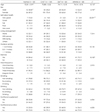Abstract
This study was carried out in order to investigate the status of food and nutrient intakes depending on the types of chronic disease of the elderly at welfare centers in Seoul. The total number of subjects was 299 elderly over the age of 60 (82 men and 217 women); they were grouped by the disease status: normal, cardiovascular disease (CVD), diabetes mellitus (DM) and arthritis patients groups. The dietary intakes were obtained by a 24-hour recall and analyzed by CAN-Pro 4.0; they were then compared with the dietary reference intakes for the Korean (KDRIs). In the results of anthropometric data according to chronic disease, the waist circumference of the normal group in males and females was lower than the other groups; in particular, the normal female group showed a lower level of waist-hip ratio, body mass index (BMI) and body fat % than those of the other groups. The arthritis group showed a higher intake of milk products than the other groups (p < 0.05); consequently, calcium intake was significantly higher than that of the other groups (p < 0.001). Vitamin A intake in the arthritis group was significantly higher than the intake in the normal and DM groups (p < 0.01). Normal and arthritis groups showed significantly higher intake of zinc and copper than the CVD group (p < 0.01). In general, about 80% of the subjects in this study revealed insufficient intakes of riboflavin, vitamin C, calcium, dietary fiber, vitamin D, biotin and potassium, compared with the estimated average requirement (EAR) or adequate intake (AI). However, sodium intake of all groups was higher than the AI of KDRIs. In conclusion, nutrient intake, according to the chronic disease, showed significant difference in some of the micronutrients, vitamin A, Ca, Zn and Cu. Therefore, we suggest that dietary guidelines, such as reducing the intake of salty foods and sweet drinks and increasing the intake of foods with sufficient calcium, vitamin D and vitamin C, are necessary to the improvement of eating habits for the elderly.
Figures and Tables
Table 2
Anthropometric data and blood pressure, blood glucose level of elderly subjects according to chronic disease

References
1. Hu SH, Kim JD. Analysis of multi-level effectiveness on life satisfaction in old age at KLIPS 2006. J Korean Gerontol Soc. 2011. 31(2):407–418.
2. Ministry of Health and Welfare. Elderly real estate survey. 2009. Seoul:
3. Ministry of Health and Welfare. 2010 statistical analysis of medical cost in Korea. 2011. Seoul:
4. Wolff JL, Starfield B, Anderson G. Prevalence, expenditures, and complications of multiple chronic conditions in the elderly. Arch Intern Med. 2002. 162(20):2269–2276.

6. Statistics Korea. 2010 statistics elderly. 2010. Daejeon:
7. Song R, June KJ, Ro YJ, Kim CG. Effects of motivation-enhancing program on health behaviors, cardiovascular risk factors, and functional status for institutionalized elderly women. J Korean Acad Nurs. 2001. 31(5):858–870.

8. Statistics Korea. A statistical table of the cause of death, 2010. Daejeon: 2010.
9. Shin JW, Park YK, Suh SR, Kim JE. Factors influencing quality of life in elderly diabetic patients of Korea: analysis from the Korea National Health and Nutrition Examination Survey in 2008. J Korean Gerontol Soc. 2011. 31(3):479–487.
10. Ministry of Health and Welfare. Korea National Health and Nutrition Examination Survey in 2010. 2011. Seoul:
11. Lee HS, Kwon CS. Prevalence of arthritis and health behavior related risk factors of the older residents in Andong rural area. J Korean Soc Food Sci Nutr. 2009. 38(9):1187–1194.

13. Stuck AE, Walthert JM, Nikolaus T, Büla CJ, Hohmann C, Beck JC. Risk factors for functional status decline in community-living elderly people: a systematic literature review. Soc Sci Med. 1999. 48(4):445–469.

14. Meydani M. Nutrition interventions in aging and age-associated disease. Ann N Y Acad Sci. 2001. 928:226–235.

15. The Korean Nutrition Society. Dietary reference intakes for Koreans. 2010. Seoul:
16. White JV, Ham RJ, Lipschitz DA, Dwyer JT, Wellman NS. Consensus of the nutrition screening initiative: risk factors and indicators of poor nutritional status in older Americans. J Am Diet Assoc. 1991. 91(7):783–787.

17. Park HJ, Hwang YJ, Kim WY. Inflammatory cytokines and dietary factors in Korean elderly with chronic disease. Korean J Nutr. 2006. 39(4):372–380.
18. Elliott P, Stamler J, Nichols R, Dyer AR, Stamler R, Kesteloot H, Marmot M. Intersalt Cooperative Research Group. Intersalt revisited: further analyses of 24 hour sodium excretion and blood pressure within and across populations. BMJ. 1996. 312(7041):1249–1253.

19. Kim HS, Park CS. Self-care and physical symptom by gender in Korean type2 diabetic patients. Korean J Women Health Nurs. 2003. 9(3):270–276.

20. Lee JH, Lee HJ, Lee IK, Yoon JS. Relationship between zinc status and obesity of type 2 diabetic women. Korean J Community Nutr. 2005. 10(1):70–78.
21. Son SM. Health Life. 2005. Seoul: The Korean Public Health Association;34–35.
22. Kim YB, Kim HK, Kim M. Characteristics of health promotion behavior and health belief of women by body mass index. Korean Growth Develop. 2003. 11(3):45–55.
23. Yang EJ, Bang HM. Nutritional status and health risks of low income elderly women in Gwangju area. Korean J Nutr. 2008. 41(1):65–76.
24. Kang MH. Nutritional status of Korean elderly people. Korean J Nutr. 1994. 27(6):616–635.
25. Son SM, Kim MJ. The effect of nutrition education program for various chronic disease in elderly visiting public health center. Korean J Community Nutr. 2001. 6(4):668–677.




 PDF
PDF ePub
ePub Citation
Citation Print
Print






 XML Download
XML Download